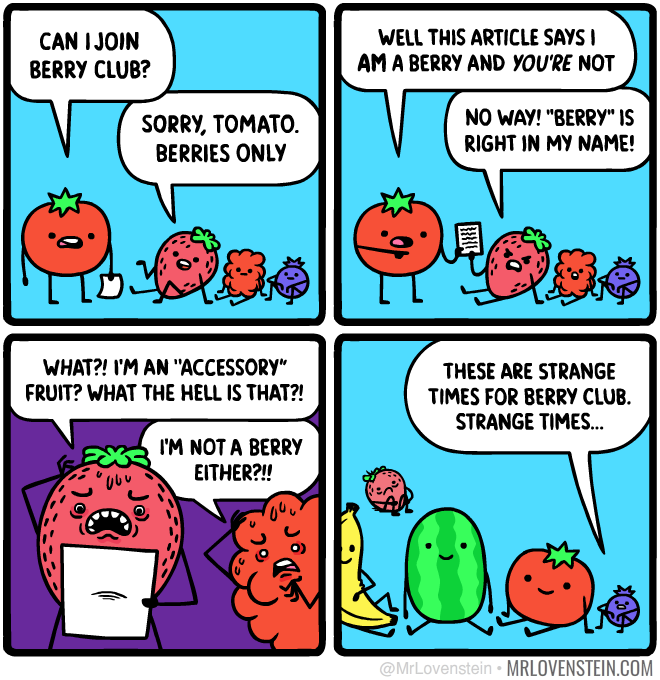Strawberries, blackberries, mulberries, and raspberries are not berries.
Bananas, aubergine (eggplants), oranges and grapes are berries.
Dangleberries aren’t real berries either.

what are strawberries and blackberries
Pretty sure pumpkins are berries.
They’re (mushrooms) also constantly listed on American menus as a “protein” option despite a dire lack of the stuff
TIL that I been deceived my entire life.
Hmm, is it really that little? The stats look devastating, like e.g. 3 grams per 100 grams, but mushrooms also consist out of 90+ grams of water.
For example, the button mushroom has:
100 g total - 91.8 g water - 1.7 g fiber = 6.5g nutrients
2.89 g protein / 6.5 g nutrients = 44.4% proteinComparing that to e.g. canned black beans:
100 g total - 70.8 g water - 6.69 g fiber = 22.51 g nutrients
6.91 g protein / 22.51 g nutrients = 30.9% proteinThat’s a neat site, and I was hoping your answer was in there, but they don’t have data on cooked mushrooms. We’ll have to do a bit of math.
So you’re taking the nutritional data provided and then shunting the fiber and water out of the way. Why? You can’t just eat the nutritional parts of food; you have to eat the whole thing, and that limits the amount of food, and thus nutrition, you can ingest in a day.
Were you thinking about food prep? Some water weight is lost there, certainly, but it’s not everything.
Let’s add a raw steak into the mix, and then we can instead look at how much water weight is actually lost when you prep these things to eat, by estimating it from data elsewhere.
The beans are ready to eat. They’re drained and rinsed. You don’t remove that water weight. So that’s 7 grams of protein per 100 gram serving.
The steak will lose about 25% of its weight when cooked, per multiple sources I found during a search. That means we need about 133 grams of raw beef to achieve 100 grams of cooked beef. So we can multiply its 21 grams of protein by 1.33, and we get about 29 grams of protein in a 100 gram serving. Their grilled steak averages around the same amount, so we’re on track so far.
Why is that discrepancy so great? I thought beans were supposed to be a great replacement for meat?
That comparison was done between beef and dry beans (note the 24 grams of protein, about the same as the beef). 100 grams of dry beans becomes about 370 grams of prepared beans. So in a 100 gram serving of beans you can actually eat, you get just over a quarter of that 24 grams protein: our ~7 grams from earlier. You also lose some water soluble protein when you rinse and drain them. They’re not the magic protein replacement people think they are.
Mushrooms are even worse. Per America’s Test Kitchen (and we’re gonna have to take these numbers at face value because I can’t find anything else), shiitake mushrooms lose about 14% of their weight in water when cooked, and cremini (think portobello, they’re just different stages of development) mushrooms lose about 60%. Thankfully the USDA’s site also has nutritional data listed for these two types of mushrooms: “minimally processed” shiitake and cremini mushrooms contain 2.4 and 3.1 grams of protein, respectively, per 100 gram serving. But those aren’t meal ready. To do that, we’ll cook the mushrooms, and they’ll shrink to 86 gram and 40 gram servings. So let’s start with enough raw mushrooms—119 grams of shiitake (or 119% of the original serving) and 250 grams (250%) of cremini. Multiply our proteins by 1.19 and 2.5 and we get a plausible range of between 3 and 8 grams of protein per 100g serving. So some are comparable to beans in their protein content! And some contain half, or less, of an already low amount when compared to the protein found in meat.
This quick comparison on Wolfram Alpha shows a similar story, with a less optimistic look at mushrooms’ possible protein content. Screenshot:

Now, the fact that you’re taking in so much more water when you eat 100 grams of beans or mushrooms than you are when you eat meat means you can eat more of them, and drink less fluids, but only to a point. And you’re certainly not getting 8 times more mushrooms than beef from a restaurant when they do a protein substitution. Getting enough protein in a vegetarian or vegan diet can be hard work. And restaurants are not making it easier by misleading people who may not know any better—I’m certain it’s careless, not malicious, but it is happening either way.
All the protein figures you have been using for the calculations have been crude protein, i.e. a estimate based on nitrogen content.
It’s much better to use DIAAS as a measure of usable protein.
https://en.m.wikipedia.org/wiki/Digestible_Indispensable_Amino_Acid_Score
Also a neat site. It seems like the ratio of usable protein would be a good addition to, but a lacking substitute for, the raw quantities. Especially given how incomplete the PCDAAS and DIAAS datasets are.
Fungi only got its own kingdom in 1969, before that they were a phylum in Plantae. There are tons of people still around who learned “mushrooms are plants” in school, so it’s not surprising downstream vocabulary hasn’t caught up.
Big Mushroom is going to take out OP, Boeing-style.
I don’t think I’ve ever considered a mushroom a vegetable, they’re just mushrooms
Let’s not forget that apples, strawberries and cashews are pseudofruits, just like the produce of my labor!
The true misconception is that there are scientific definitions and culinary definitions. No the culinary definitions don’t fit their scientific category. They’re not intended to.
The whole fruit/vegetable controversy only comes because we’re trying to use two different domains of terms interchangeably: botanical terms and culinary terms.
Tomatoes (and squash, and pumpkins (which, side note, are a type of squash), and cucumbers) are botanically fruits, but culinarily they’re most commonly used as vegetables because they tend to be less sweet, particularly when raw. Mushrooms are botanically…well, I guess they’re botanically “n/a”, as they’re not a part of the plantae kingdom, but whatever–they’re typically considered botanical, so they’re “botanically” fungi, but culinarily they’re most commonly used as vegetables (or, interestingly, as meat replacements).
We get into the same linguistic confusion when we start throwing around “peanuts aren’t nuts, they’re legumes!”–botanically, yes, peanuts are legumes, but culinarily they’re most commonly used as nuts. See also: “green beans” are botanically pods, not beans, but we use them culinarily as vegetables; and many “berries” are botanically something else but we use them culinarily as berries; meaning they’re often left whole, mixed with other berries in the same dish, and go well with cream in cold summer desserts.
The whole thing is a misguided exercise in pedantry; “technically burritos aren’t sandwiches, they’re meat-sacks!” They’re both, and we instinctively understand that trying to compare the two terms is silly because “sandwich” is a culinary term and “sack” is not.
Another funny part of this is that pedants are trying to say that tomatoes are (botanically) fruits and not vegetables, but the closest thing to a definition we have for “vegetable” botanically is “literally all plant life and maybe also some fungi,” so tomatoes are clearly both fruit and vegetable botanically.Plus, they’re culinarily used as vegetables, but can also be used as fruits in some cakes, pies, sorbets, and so forth (and isn’t ketchup just a tomato smoothie?), so tomatoes are clearly both fruit and vegetable in culinary terms as well.edit: Someone who actually knows what they’re talking about (an ecologist) has corrected my botanical definition of “vegetable.” Actually, they’re “edible parts of a plant which are not fruit.” Which means that tomatoes are explicitly excluded as vegetables, being botanically a fruit. I don’t think that ruins my overall point in any way, though.
good post, sounds like a copypasta
Alas, it’s all me. I…tend to be a bit verbose.
Vegetable isn’t a biological term. While fruit is a biological term, but it’s also a culinary term just like vegetable.
Actually, “mushrooms are technically meat” is a new hill I’d like to die on. Mushrooms have animal cells, ergo, definitely not a vegetable.
The controversy isn’t about what they are, it’s about what we call them and which categories we put them in on charts. It’s like arguing over silly group names - is it a murder of tomatoes or a flock?
deleted by creator
The cast of Vegitales lied to me!
Leave mycelium alone
Why is it yourcelium
Sure, but they are fun guys!












